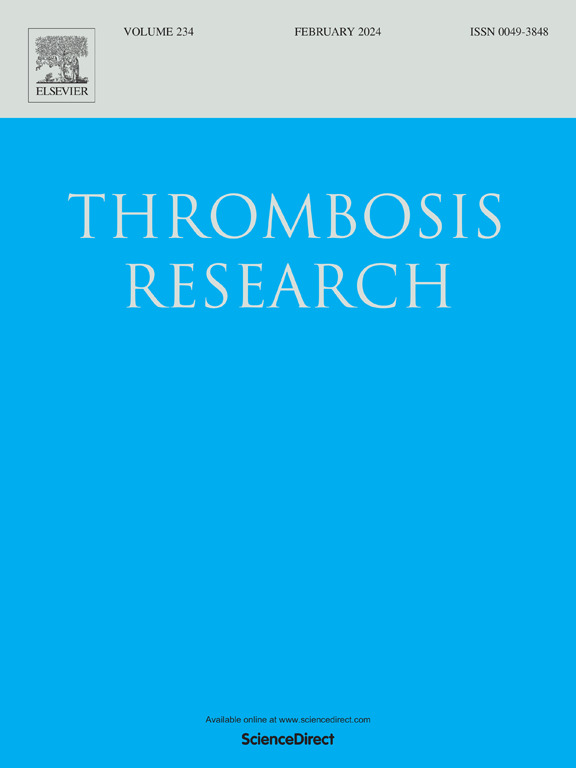血栓调节蛋白Arg403Lys突变损害蛋白C激活,增加血栓形成风险
IF 3.4
3区 医学
Q1 HEMATOLOGY
引用次数: 0
摘要
凝血调节蛋白(Thrombomodulin, TM)是多种生理过程的重要调节因子,包括凝血、纤溶和炎症。TM通过与凝血酶结合发挥其对蛋白C (PC)活化和凝血酶活化纤维蛋白溶解抑制剂(TAFI)活化的辅助因子活性。大量研究报道,TM突变与血栓栓塞性疾病有关。在这里,我们报道了在TM的第四个表皮生长因子(EGF)样结构域的氨基酸残基403 (Arg403Lys, R403K)上精氨酸被赖氨酸杂合取代,这是在5名不相关的血栓患者中发现的。为了阐明R403K突变在TM中的作用,我们构建了TM全长(Met1 ~ Leu575残基)和胞外片段(Met1 ~ Ser515残基)的表达质粒,研究其在内皮细胞表面和体外系统中的功能。我们在几个实验中观察到TM-R403K变体的PC激活的辅因子活性降低,并证明突变体与PC之间的相互作用减弱。这些结果表明,TM中的R403K突变可诱导TM抗凝功能的有害改变,这可能解释了患者观察到的血栓易感性。本研究进一步提供了令人信服的证据,表明TM中EGF4结构域末端的突变可能与血栓形成有关,从而增强了我们对TM生理作用的理解。本文章由计算机程序翻译,如有差异,请以英文原文为准。
Thrombomodulin Arg403Lys mutation impairs protein C activation and increases thrombosis risk
Thrombomodulin (TM) is an important regulator in various physiological processes, including coagulation, fibrinolysis and inflammation. TM exerts its cofactor activities for protein C (PC) activation and thrombin-activatable fibrinolysis inhibitor (TAFI) activation through its binding with thrombin. Numerous studies have reported that mutations of TM are associated with thromboembolic diseases. Here we report a heterozygous substitution of arginine to lysine at amino acid residue 403 (Arg403Lys, R403K) within the fourth epidermal growth factor (EGF)-like domain of TM, which was identified in five unrelated patients with thrombophilia. To elucidate the role of the R403K mutation in TM, we constructed expression plasmids for both the full-length (residues Met1 to Leu575) and extracellular fragment (residues Met1 to Ser515) of TM to study its functions on surface of endothelial cells and in vitro system as well. We observed a reduced cofactor activity of PC activation by the TM-R403K variant across several assays and demonstrated a weakened interaction between the mutant and PC as well. These results indicate that the R403K mutation in TM induces detrimental alterations in the anticoagulant function of TM, which might elucidate the thrombotic predisposition observed in patients. This study provides further compelling evidence suggesting that mutation at the terminus of the EGF4 domain in TM may be associated with thrombophilia, thereby enhancing our comprehension of the physiological role of TM.
求助全文
通过发布文献求助,成功后即可免费获取论文全文。
去求助
来源期刊

Thrombosis research
医学-外周血管病
CiteScore
14.60
自引率
4.00%
发文量
364
审稿时长
31 days
期刊介绍:
Thrombosis Research is an international journal dedicated to the swift dissemination of new information on thrombosis, hemostasis, and vascular biology, aimed at advancing both science and clinical care. The journal publishes peer-reviewed original research, reviews, editorials, opinions, and critiques, covering both basic and clinical studies. Priority is given to research that promises novel approaches in the diagnosis, therapy, prognosis, and prevention of thrombotic and hemorrhagic diseases.
 求助内容:
求助内容: 应助结果提醒方式:
应助结果提醒方式:


